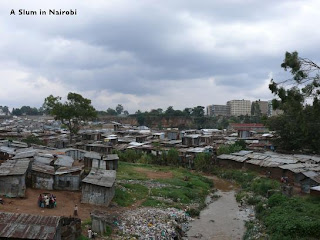
"Migrants from impoverished hinterlands, living without security, public health, and, often, clean water in the shantytowns of São Paulo, Lagos, Karachi, Dhaka, and Jakarta, have as much in common with each other as "People Like Us"–the global class of businessmen, journalists, academics, and anti-terrorism experts–do among themselves." –Pankaj Mishra, Bombay: The Lower Depths, New York Review of Books, November 18, 2004.
Lagos as a whole has been dubbed 'a slum' by foreign journalists that is, if we check her characteristics against UN’s operational definition[3]: a human settlement in an urban area that has the following characteristics:
1) inadequate access to safe water; in sufficient amounts at an affordable price
2) inadequate access to sanitation and other infrastructure;
3) poor structural quality of housing;
4) overcrowding; and
5) insecure residential status that permits forced evictions
6) Insufficient living space in households which means not more than 3 people sharing the same room
Based on this criteria we have to agree that 70% of Lagos inhabitants are Slum dwellers [Bariga, Ajegunle, Mushin, Igbosere, Lekki, Sango, Ijora, Agbogbon etc]. No offence to our dear hard working Governor Babatunde Fashola.
Slum dwellers are human beings with hopes and aspirations for a better life and future for their children. That was what the BBC reporter who recorded the most maligned “Welcome to Lagos” documentary was trying to show.
The houses found there are pretty run-down. Many are made of scrap - tarpaulin [torn off bill boards], bits of metal and wood. Many don’t have access to water and electricity and end up tapping power illegally from a neighbors in life threatening situations eg. a man from Kuramo was electrocuted while transferring live wires under water. Open defeacation or flying toilets" - plastic bags used for defecation and then tossed - substitute for a sanitation system.
For those living in the riverine parts, the water which is a source of livelihood for the fishermen is also the waste and refuse disposal site for the community. Thus the part of the water nearest to the homes is clogged with human waste. This renders the water undrinkable and generally unusable for any normal human activity: bathing, washing of plates, cooking. But I can wager that in dire circumstances, they will be used.
Currently, these characteristics describe communities that comprise 43% of the combined urban populations in all developing countries, and 78% of the urban population in least developed countries [3]. Thus, in many developing countries, life in slum settlements has already become the norm of urban human existence.
Population growth/urbanization trend
The world's urban population is increasing by about 70 million people a year [3]. Africa’s urban population is increasing faster than anywhere else in the world. If the current trend continues, the urban population of Africa is projected to more than double its 2007 level of 373.4 million by 2030. By 2050, half of Africa’s population will be urban. With a projected population of about 1.2 billion people, African cities will host nearly a quarter of the entire global urban population. And as urbanization increases, so too the growth of slums.
The world's urban population is increasing by about 70 million people a year [3]. Africa’s urban population is increasing faster than anywhere else in the world. If the current trend continues, the urban population of Africa is projected to more than double its 2007 level of 373.4 million by 2030. By 2050, half of Africa’s population will be urban. With a projected population of about 1.2 billion people, African cities will host nearly a quarter of the entire global urban population. And as urbanization increases, so too the growth of slums.
Governance
Another reason slums develop is bad governance. Governments often fail to recognise the rights of the urban poor and incorporate them into urban planning, thereby contributing to the growth of slums. In addition, many countries simply cannot respond to rapid urbanisation quickly enough. People are coming to cities far faster than the planning process can incorporate them. Often, they find their own land and build a shack before the government has a chance to learn of their existence.
It is not simply about water or drainage or housing. It is about putting into motion the economic, social, institutional and community activities that are needed to turn around downward trends in an area. These activities should be undertaken cooperatively among all parties involved—residents, community groups, businesses as well as local and national authorities if applicable.
Slum dwellers are part of the urban populace, with the same democratic rights to environmental health and basic living conditions as all residents. These rights are often limited by a government’s ability to realise them. The governments must accept the reality of urban growth, only then can they plan for it and determine where the new residents will live. Authorities should identify land and plan for its settlement even if money is not available for urban services. Once people settle on that land and feel that they have a right to live there, they will begin investing in it. Over time, the area will upgrade incrementally.
An example of an upgraded slum is Rocinha, the largest favela in Rio de Janeiro which has evolved from a squatter community predominantly consisting of wooden shacks, dirt and gravel streets and alleys, to a community with predominantly concrete and brick houses, paved streets, metered electricity, and piped water [1]. Even private banks and businesses have moved in [1].
Much of this transformation took place through the actions of community associations and other self-empowerment organizations that took advantage of their large population size as an economic incentive to lure in formal sector businesses and service providers [1]. Similar transformations have taken place in other shantytowns in major urban centers, especially in Asia, South Africa and Latin America. Lagos needs to join this 'change train' asap!



No comments:
Post a Comment